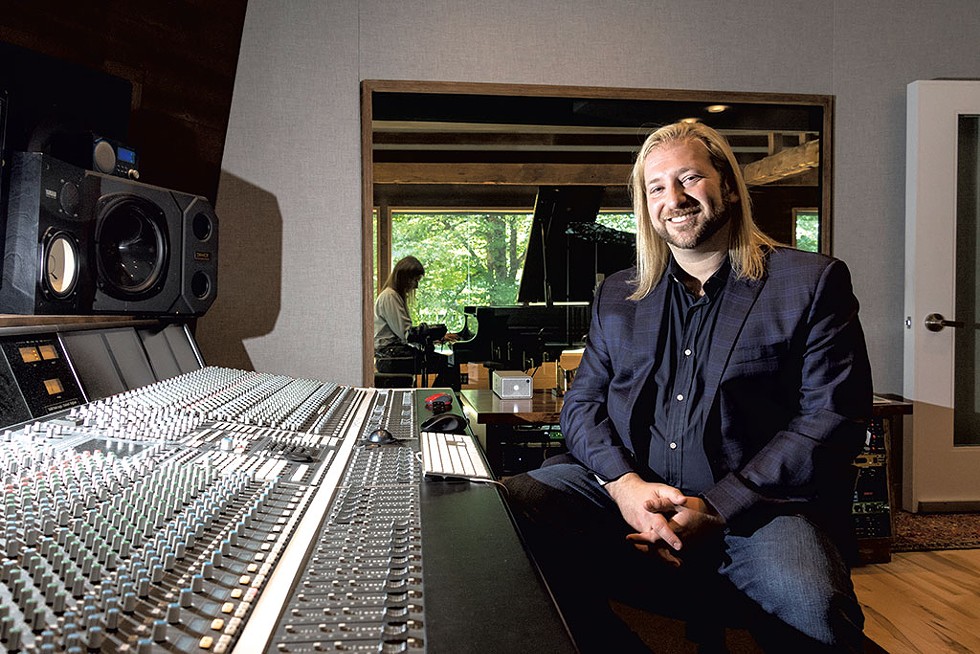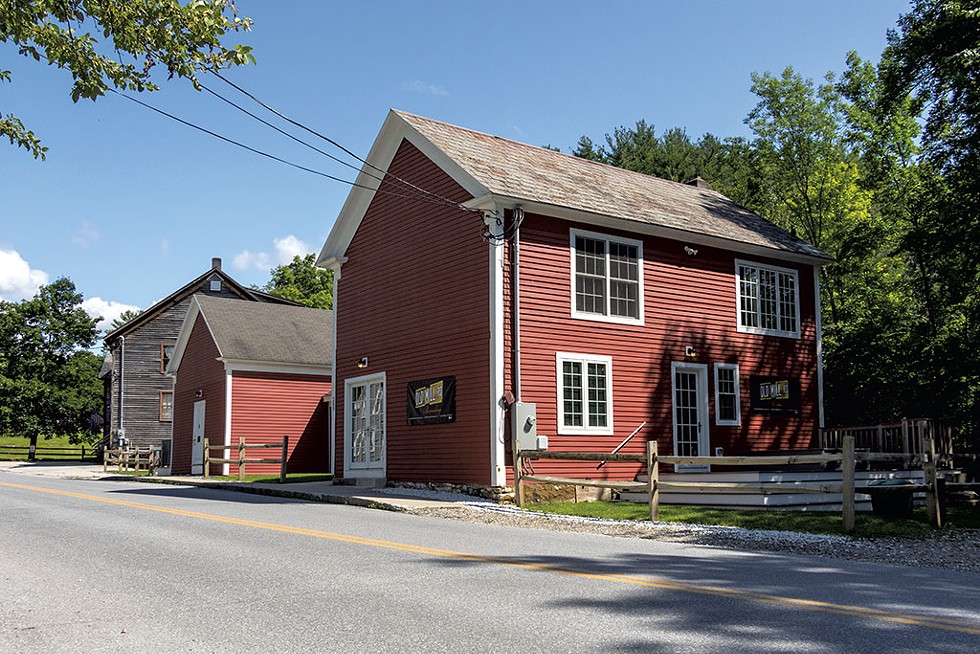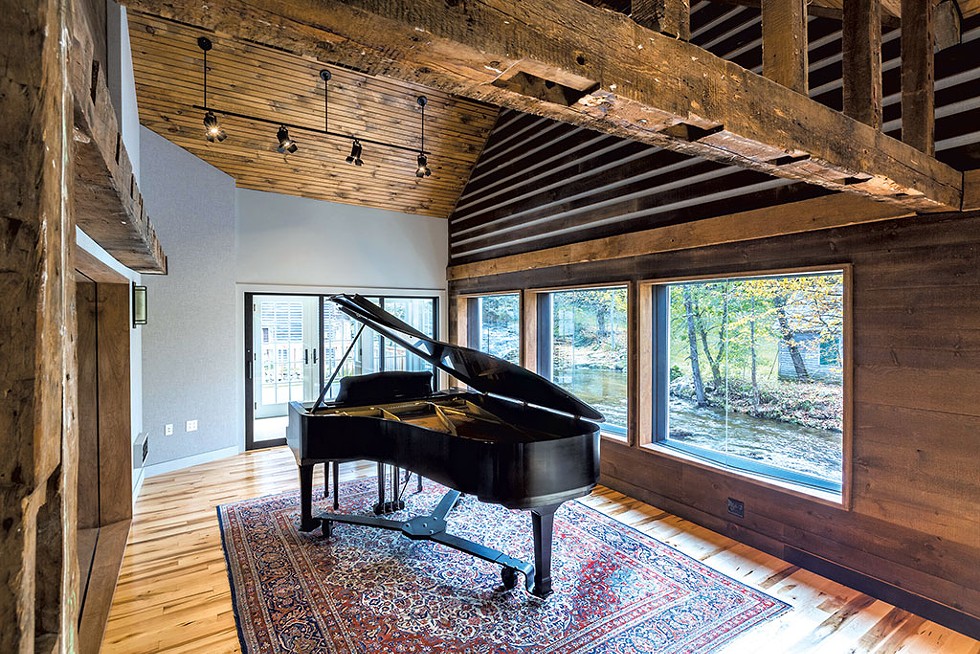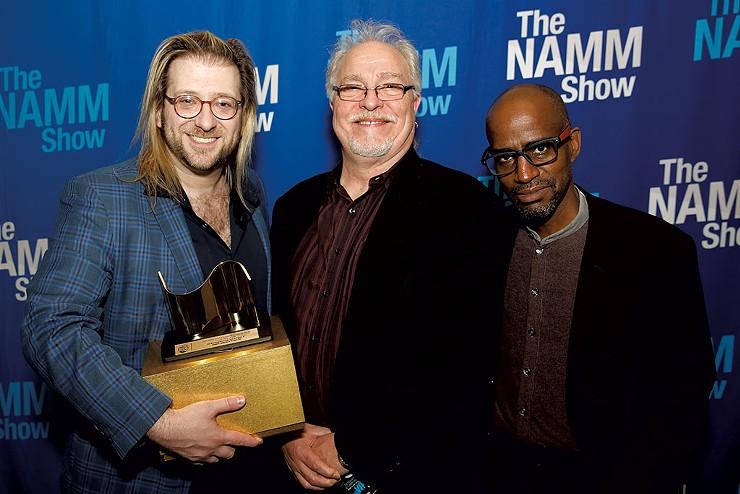
- Zach Stephens
- Joshua Sherman
The aura of idyllic Americana is so strong along this strip that you might think you've stumbled into a Norman Rockwell painting. In a way, you have. The American illustrator used Arlington and his neighbors as models when he lived there in the 1940s and '50s. One of his most famous paintings, "Shuffleton's Barbershop," was set inside the IGA building before it was a grocery.
Today's Arlington isn't quite Rockwell's, though. For one thing, "the Deacon" never drove cars like the sleek Audi and Jeep SUVs parked in a narrow dirt lot beside the mill. For another, even as sleepy Vermont villages go, this one is awfully quiet. Traffic is infrequent. Aside from a worker fixing the eaves of one of the colonials and the occasional tourist at the chocolate shop, there's hardly a soul about.
Most of the buildings on this quarter-mile stretch of Old Mill Road belong to Joshua Sherman, a Broadway producer and set designer turned physician turned real estate entrepreneur and would-be media mogul.
Sherman, 41, has acquired a huge swath of East Arlington — a total of 23 buildings and more than 60 acres — under the banner of Old Mill Road Media. He's turned it into a campus featuring a high-end recording studio, housing, and offices for the several print publications he owns and operates.

- Zach Stephens
- Old Mill Road Recording in Arlington
Sherman envisions Old Mill Road Media as an incubator for artistic projects, a production facility, a distribution outlet and a promotional vehicle all rolled into one. "Think of it like Paramount Pictures and Paramount Studios," he said. "One feeds into the other."
He aims, in short, to revive, embrace and leverage the village's faded history as an artistic and commercial hub. When he's done, the town may still not look as it did in Rockwell's era. But it will, Sherman hopes, become a haven for a new generation of artists.
"Let's take revolutionary ideas and the Arlington artists' colony, and let's put it into this new model that really embraces How can we make a difference?" Sherman said. "The idea is that you don't throw away history; you embrace history. And then you reinvent for the next generation."
It's generally easy to tell which structures along Old Mill Road are Sherman's: On the north side of the street, his buildings are white with red trim; on the south, they're red with white.
"It really makes people feel like you're on a set," Sherman observed while guiding a reporter around his growing colony.
He also owns the mill and an adjoining property, both of which were built in the 1760s by Remember Baker, a cousin of Ethan Allen and Seth Warner and a member of the Green Mountain Boys. Sherman doesn't own the Village Peddler and Chocolatorium, the fire station, or a handful of other private homes at this end of Old Mill Road. But the sheer number of his holdings there, plus more on nearby Ice Pond Road and East Arlington Road, has started a joke circulating among his neighbors.
"People ask me all the time if I'm going to rename Arlington 'Shermanville,'" Sherman said outside the Mill. "I tell them, 'If Arlington was good enough for the Green Mountain Boys and Norman Rockwell, it's good enough for me.'"
The Kings and I
Affable and energetic, Sherman doesn't sleep much, he said. He wears his dirty-blond hair long, framing a friendly bearded face with soft yet alert eyes. He smiles easily and converses with an almost salesman-like slickness, but he's not pushy. And if he sometimes shows a tendency toward name-dropping, he comes by that honestly.
His mother, Eileen Bluestone Sherman, is an Emmy Award-winning playwright and lyricist. His aunt, Gail C. Bluestone, is a composer. Sherman grew up in the entertainment biz, where he forged a career that involved rubbing elbows with the likes of Judd Hirsch, Matthew Broderick and Parker Posey.
As a child in Kansas City, Mo., he was immersed in music, dance and visual art. By 16, Sherman was living in New York City, well on his way to a career as a theater designer, working under the tutelage of artist Al Hirschfeld and Oscar-, Tony- and Emmy-winning designer Tony Walton, both of whom he considered close mentors.
"I was 'the Kid,'" Sherman recalled. "It was an old-school apprenticeship." Among his early career highlights was serving as an assistant to Walton on a 1999 production of Annie Get Your Gun starring Bernadette Peters.
Meanwhile, he was enrolled full time at Marymount Manhattan College. Nearing graduation, Sherman learned that he needed a basic science course to complete his degree. He chose nutrition and soon discovered that the arts and sciences weren't so far apart.
"I realized that the skills I used in the arts were a lot of the same skills you use in medicine," he explained. "Communication and listening skills, an ability to ask questions, attention to detail, a love of research."
While Sherman's father, Neal, was a doctor, he said he'd never considered a career in medicine before his aha moment — or rather, what he calls his "Legally Blonde moment."
"I thought, I could be a doctor," he said with a sarcastic shrug.
No one who knows Sherman will tell you he lacks confidence. But he was right. He burned through premed classes at Marymount and was accepted at Renaissance School of Medicine at Stony Brook University on Long Island. In a gap year before med school, he switched gears from designing musicals to producing them, because the latter gave him more time for his medical education.
"As a designer, you're always working on seven different projects at once," he said. As a producer, by contrast, Sherman could develop musicals and compose music around his school schedule and residency.
His most significant production during this period was Rockwell, an off-Broadway musical about Norman Rockwell written by his mother with music composed by his aunt. In 2001, he produced The Odd Potato: The Broadway Album, a recording of the music from a show based on a children's book written by his mother, who'd based it on his grandfather. The record featured 20 Tony winners, including Hirsch and Lillias White. Grammy winner Ben Arrindell engineered the record, marking the start of two decades of collaboration with Sherman.
In 2009, Sherman was looking for a change when he found himself in southern Vermont, where his family had regularly vacationed when he was a kid. The Shermans' holiday cards often depicted him and his sister beside Peter's Brook.
One day Sherman had breakfast with friends, including the late local playwright Fred Carmichael and his wife, Pat, who suggested he give country living a try. At their urging, he signed on to work for a year at Bennington's Southwestern Vermont Medical Center in internal medicine and critical care.
For a time, Sherman alternated weekly between producing in New York and doctoring in Bennington.
"That got really old really quickly," he said.
Tired out, he transplanted his theatrical career to Vermont, where he produced a series of mini-musicals called "Charmers" and a TV pilot. Despite a local talent pool full of performers and industry pros, Sherman eventually realized he lacked the infrastructure to produce content at the level he wanted. Specifically, there was no studio that could produce high-quality sound.
In 2013, Don and Verrall Keelan, the owners of Gristmill Antiques at Candle Mill Village in East Arlington, approached Sherman about buying the mill. He acquired that building in 2014, along with Baker's homestead and the old schoolhouse, and set about renovating them.
First came the mill, which became both Sherman's headquarters and a cozy performance space. Sherman declined to say how much the down-to-the-studs restoration and reno cost him, but it clearly wasn't cheap. Modern convenience and history blend seamlessly throughout the spacious building, from the sleek, modern kitchen to a versatile stage area to staircase railings made of wheels from the original grist mill.
The building reopened as the Mill in 2015 — though, Sherman noted, he's not done with its restoration. "With buildings from the 1700s, you're never really finished," he said.
Still, the Mill was finished enough for him to move on to his next project: converting the old schoolhouse into a world-class recording studio. He hired renowned acoustic designer Francis Manzella, since deceased, to design the studio and invited Arrindell to run it.
"I told Ben we could build the studio of his dreams in Vermont," Sherman recalled, "but I'd only do it if he came with me."
The Music Men

- Courtesy of David Barnum
- Yamaha grand piano in the live room
Arrindell is a native New Yorker whose credits include mixing tracks for Aretha Franklin, Busta Rhymes, Janet Jackson, Mary J. Blige, En Vogue and Slick Rick. He jumped at the chance to move to Vermont and said he hasn't looked back.
"When I go to New York now, people are always like, 'Do you miss the city?'" Arrindell said. "And I'm like, 'Uh, not really.'"
While the Mill is the nerve center of Sherman's campus, Old Mill Road Recording is its beating heart. Opened in 2018, the studio has state-of-the-art equipment throughout, plus a full kitchen, a spacious live room, and numerous nooks and crannies where artists can relax or refocus between sessions.
But the crown jewel of the studio, and perhaps of Sherman's entire sprawling complex, is the piano room. In its southeast corner, floor-to-ceiling windows overlook the brook as it flows past the Mill. From the center of the room, it's impossible to hear the rush of water or the street traffic on the building's other side. The vocal booth has a view past the piano to the river.
"The idea is to be inspired while you're here," Sherman said. "I think we've done that."

- Courtesy of Namm
- From left: Joshua Sherman, Francis Manzella and Benjamin J. Arrindell after winning the NAMM TEC Award for Studio Design in January 2020
He's not alone in thinking so. Last year, the studio won a National Association of Music Merchants Technical Excellence & Creativity award for studio design, which Arrindell described as "the Grammy for recording studios." He would know. The veteran hip-hop and R&B engineer has a Grammy of his own, now joined on a shelf in the control room by the NAMM TEC trophy.
Sherman, who is a Grammy voter, envisions Old Mill Road Recording as a destination and retreat for national and international recording artists. But the pandemic has submarined those ambitions for now.
So far, the studio has two signature releases: Get Yourself Some Happy!, the debut album from Broadway actor Lillias White, which is due out later this month; and Clean, the 2020 debut of rapper and recovering addict Benjamin Lerner. Sherman believes more artists will come, given his and Arrindell's connections in the music and theater worlds.
Related Rapper Benjamin Lerner Champions Recovery on Debut Record 'Clean'

In the meantime, Old Mill Road Recording remained busy throughout the pandemic, Sherman and Arrindell said, thanks to a mix of projects by local artists, in-house podcasts and radio work, and postproduction jobs for the likes of Netflix.
Sherman said the studio has also helped Arlington residents grasp his vision for the entire campus.
"When I did the Mill, people didn't really know what it was," he said. "But people understand a recording studio. It puts the pieces together. And that's opened a lot of doors."

- Courtesy of David Barnum
- 48-channel SSL Duality and custom speakers in the live room
Newsies Reel
Old Mill Road Media employs about 20 people. Most of them can be found on the mastheads of the print publications that Sherman owns and operates with his wife, Carolyn Blitz, from offices in the old IGA.
The couple met when Blitz approached Sherman about a profile in Manchester Life, a magazine she founded. When they married in 2018, she owned Stratton Magazine. Sherman bought Vermont Magazine and Vermont News Guide in 2019. Last year, he expanded his reach with a regional publication, Berkshire Magazine.
While each mag serves a different audience and purpose, collectively they play a key role in Old Mill Road Media. The campus has housing where artists can create and workshop ideas. The studio offers a place to produce them. But creative products need to be distributed, and, as Sherman noted, "You can't have distribution without promotion."
That's where the magazines come in — not as promotional outlets for Old Mill Road projects per se, but as a means to highlight southern Vermont and sell the whole region as a thriving destination.
Describing his approach to his work, Rockwell once said, "I paint life as I would like it to be." Sherman espouses the same philosophy, particularly in the pages of his magazines.
"Making a difference doesn't have to be big," he said. "I love the fact that we're in a position to help promote all the wonderful things going on in our community. I love the fact that we're in a position to promote all of the things that need to change in our community, that need to grow."
East Side Story
What exactly needs to change in East Arlington? The village's history as a hub of creativity and commerce dates back to the 1770s, when the Green Mountain Boys plotted revolution there. One hundred years later, Hale Furniture manufactured prosperity that lasted another century.
Now, however, community members speak of a part of town left behind by development in nearby Manchester. Whether or not they grasp the full scope of Sherman's ambitions, many are encouraged by the progress he's made and excited by the possibilities of his development.
Denise Monte, whose family has owned the Village Peddler and Chocolatorium for 30 years, remembers when East Arlington was a vibrant tourist destination. Anchored by the Candle Mill, from the 1950s through the early 1990s the strip claimed a dozen or so shops and boutiques and a handful of restaurants and cafés. Most were family-owned, she said. But new generations didn't take over the businesses, so one by one they closed.
In Sherman, she sees optimism for a return to some of that former glory.
"No town, no neighborhood, no anything wants to have run-down buildings in it," Monte said. "So it's positive that he has taken buildings that were just sitting vacant and weren't being used — that were beautiful buildings that were treasured, really — and is working on them."
She hopes the renovations will attract more businesses to the area, noting that locals Bonnie and Clyde Baker recently opened a new market at the end of Old Mill Road: Bonnie & Clyde's Corner Market, of course.
"The businesses that are here are helping to support [Sherman], as well as him supporting us," Monte said. "We need to have a variety of things available for people, and I think we're on that path."
One thing about the development does dismay her: The public no longer has access to Peter's Brook by the mill. Sherman rebuilt much of the bank behind the mill and recording studio as a sort of riverside oasis — beautiful but private.
Still, Monte sees Sherman's influence as a net positive for East Arlington.
"I wish Josh the best," she said. "I hope that [the development] will be prosperous and a good mix for the community."
Sherman claimed that he never intended to acquire as much real estate as he has. Rather, he said, neighbors heard about the sales and offered to sell him their own property — a snowball effect. He made the purchases with the income from his medical career, he said.
No longer working for the hospital, Sherman is still a practicing physician associated with the Battenkill Valley Health Center in Arlington. His longtime status as a doctor in the area grants him some familiarity with locals. Still, he conceded that he encountered skepticism and suspicion at the outset of his endeavor.
"But I think, once people got a sense of what we were really trying to do, they embraced it," Sherman said. He added, "I care more about growing the community than I do about growing the number of properties I own."
Arlington town administrator Nick Zaiac backed up that assessment. He described Sherman as a "quintessential real estate entrepreneur," but one who "cares a lot about his community" and is trying to make East Arlington better through his investments.
That doesn't mean Sherman's relationship with the town has always been smooth sailing.
"There's certainly growing pains every time a place sees investment after it hasn't for some period," Zaiac said, noting "bits of pushback" from the town. In particular, he said zoning hearings related to Sherman's property "were heated."
Keelan, who sold Sherman the Mill, had a different impression. A retired CPA and real estate developer and a cofounder of the Arlington Area Renewal Project, he said the meetings with Sherman were no more contentious than typical tussles over zoning.
Asked if he was aware of anyone in Arlington who's displeased with Sherman's development, he said, "No, not at all.
"If anything, it's just the opposite," Keelan continued, adding that the Arlington Area Renewal Project is lobbying the town to improve the infrastructure of East Arlington so that Sherman can keep expanding. "He's been a fabulous asset to the community," Keelan said.
On that, Zaiac agreed, saying, "Josh has been wonderful to work with, and we're excited to see what he does next."
So is Sherman.
"How big is this gonna go?" he asked rhetorically. "The answer is, there's no limit to what I'd like to potentially see happen. But it's very organic, based on the talents that are here.
"I started off as a set designer," Sherman continued. "And what does a set designer do? They set the stage for action to happen. They think about flow, they problem solve and they just set up others to succeed in showcasing their craft."
Related Rapper Benjamin Lerner Champions Recovery on Debut Record 'Clean'

Related Stuck in Vermont: Benjamin Lerner and Joshua Sherman Team Up to Make Music About Recovery: Episode 643













Comments
Comments are closed.
From 2014-2020, Seven Days allowed readers to comment on all stories posted on our website. While we've appreciated the suggestions and insights, right now Seven Days is prioritizing our core mission — producing high-quality, responsible local journalism — over moderating online debates between readers.
To criticize, correct or praise our reporting, please send us a letter to the editor or send us a tip. We’ll check it out and report the results.
Online comments may return when we have better tech tools for managing them. Thanks for reading.